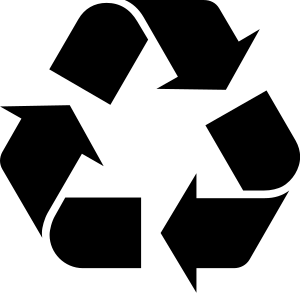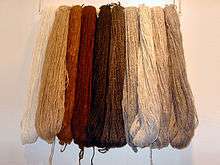Textile recycling
Textile recycling is the method of reusing or reprocessing used clothing, fibrous material, and clothing scraps from the manufacturing process. Textiles in municipal solid waste are found mainly in discarded clothing, although other sources include furniture, carpets, tires, footwear, and non-durable goods such as sheets and towels.
Textiles and leather recycling categories
- Cotton Recycling
- Wool Recycling
- Burlap, Jute, and Sisal Recycling
- Polyurethane Foam Recycling
- Polyester and Polyester Fiber Recycling
- Nylon and Nylon Fiber Recycling
- Other Synthetic Fiber Recycling
- Rags and Wipers
- Used and Recycled Bags
- Used Clothing
- Leather Recycling
- Textile Recycling Employment
Textile collection

For consumers the most common way of recycling textiles is reuse through reselling or donating to charity (Goodwill Industries, Salvation Army, etc.). However, certain communities in the United States have been accepting textiles in curbside pickup since 1990. The textiles must be clean and dry in order to be accepted for recycling. For instance, in 2018 the city of Sommerville, MA began a curbside textile recycling program with the city's contractor, Simple Recycling. Each resident receives two pink recycling bags for free for their clothes and other household textiles. The bags are picked up by the contractor and replaced with the same number of bags.[1] Officials in Niles, IL claimed residents diverted over two tons of waste from the landfill with the voluntary textile recycling program in August 2018. The say that the program will help reduce landfill costs as well as add additional revenue from the textiles that will "trickle down to the taxpayer."[2] Additionally, Simple Recycling also operates the program in Niles, IL. They pick up the bags, weigh the donations, and pay Niles $20 per ton. The donations are then sorted and sent to thrift stores, overseas markets, or shredded for insulaiton and other industrial purposes.[2]
Some companies, such as Patagonia, an outdoor clothing and gear company, accept their product back for recycling.[3] Other companies, like USAgain, are for-profit textile recycling companies using collection bins at a variety of sites.[4] Textile recycling equipment plays an important part in the textile recycling industry - Standard and high-efficiency textile recycling equipment is quite important for supporting the textile industry. So far,the most popular and widely accepted clothing recycling bin use a high safety chutes that are easily opened and closed.
Some textiles can be remade into other pieces of clothing, while damaged textiles are sorted out to make industrial wiping cloths and other items.
Resale
After collection of the textiles, workers sort and separate collected textiles by color, size and quality, it is then packed, baled and sold as good reusable clothing. Shoes are reused by being resold as well. This process not only creates local jobs, it helps stimulate local economy.
Obstacles
If textile re-processors receive wet or soiled clothes, however, these may still end up being disposed of in landfill, as washing and drying facilities are not present at sorting units. This then affects the environment.[5]
Process
Clothing fabric generally consists of composites of cotton (biodegradable material) and synthetic plastics. The textile's composition will affect its durability and method of recycling.
Fiber reclamation mills grade incoming material into type and color. The color sorting means no re-dying has to take place, saving energy and pollutants. The textiles are shredded into "shoddy" fibers and blended with other selected fibers, depending on the intended end use of the recycled yarn. The blended mixture is carded to clean and mix the fibers and spun ready for weaving or knitting. The fibers can also be compressed for mattress production. Textiles sent to the flocking industry are shredded to make filling material for car insulation, roofing felts, loudspeaker cones, panel linings and furniture padding.[6]
For specialized polyester-based materials the recycling process is significantly different. The first step is to remove the buttons and zippers; then the garments are cut into small pieces. The shredded fabric is then granulated and formed into small pellets. The pellets are broken down polymerized and turned into polyester chips. The chips are melted and spun into new filament fiber used to make new polyester fabrics.[7]
Some companies are creating new pieces of clothing from scraps of old clothes. By combining and making new additions, the eclectic garments are marketed as a type of style.
Statistics
| Year | Percent of textile recovered in the U.S.[8][9] |
|---|---|
| 1960 | 2.8% |
| 1980 | 6.3% |
| 2011 | 8% |
References
- ↑ "Somerville launches curbside textile recycling program - The Boston Globe". BostonGlobe.com. Retrieved 2018-08-14.
- 1 2 Bookwalter, Genevieve. "Clothing, textile recycling program in Niles bringing cash to village as items bypass landfill". chicagotribune.com. Retrieved 2018-08-14.
- ↑ Patagonia Common Threads Garment Recycling
- ↑ Mitchell, Kathy. "People, planet, profit focus of Stone Mountain textile recyclers". The Champion Newspaper. Retrieved 4 September 2013.
- ↑ Councils "need to understand" importance of textile quality, www.letsrecycle.com, Retrieved 24.11.06
- ↑ "textiles recycling".
- ↑ Common Threads Garment Recycling
- ↑ EPA. Municipal Solid Waste Generation, Recycling, and Disposal in the United States: Facts and Figures for 2003.
- ↑ "Municipal Solid Waste in the United States: 2005 Facts and Figures" (PDF).

